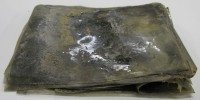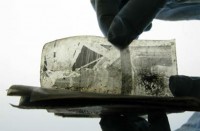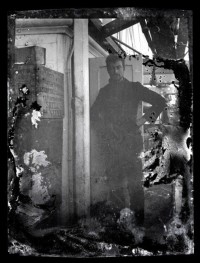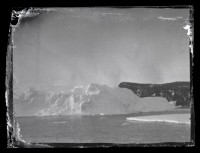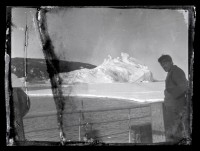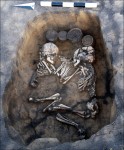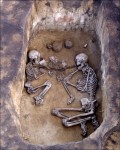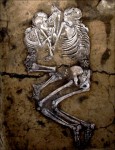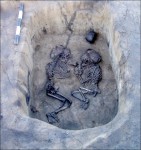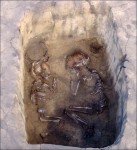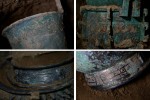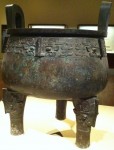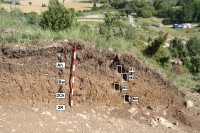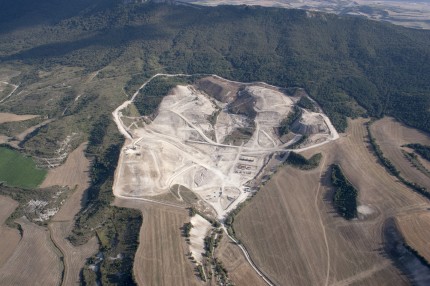Time marches inexorably on, devouring our precious remaining minutes, hours and days like Cronus did his children, and miring us in so many end-of-year retrospectives and best-of listicles that we can’t help but embrace the new year if only for the novelty of it. So it’s for your own good, really, that for the third time in a row I will close out the year with a look back at The History Blog’s 2013.
First a little glimpse into the statistical man behind the curtain. This year we had 1,570,000 total pageviews, slightly short of last year’s high of 1,650,546. That’s actually way better than I expected, because earlier this year I experienced for the first time the frigid wrath of a Google denied. You might recall that towards the end of January the blog moved to a new server. This was made necessary by my unquenchable thirst for large pictures taking up so much space that I finally had to ditch the old one and move to a plan that gave me room to grow.
Or so I thought. In fact, it was a complete disaster, way too small to handle my bandwidth and even the overall hard drive space was larger, it was still pretty damn stingy in terms of file size maximums. As soon as the blog moved, it was taken down by an exceeded bandwidth error and remained down for what felt like an eternity but was actually something like eight hours.
As far as Google’s algorithms are concerned, those eight hours might as well have been an eternity. The high ranking I had built up over six years of daily blogging plummeted resulting in a dramatic drop in traffic. I watched, horrified, as my views per day plunged to levels not seen since the end of 2011, beginning of 2012, and there wasn’t a damn thing I could do about it. A second bandwidth exceeded takedown struck at the end of March and that was the end of my dealings with that server company. I moved to a new service (hi Westhost! Love you guys!) in mid-April with unlimited everything and it’s been smooth sailing ever since.
Alas, the search engines weren’t done punishing me. They still aren’t done, in fact. The numbers only started to crawl back up in September, believe it or not, and even now we’re tens of thousands of views away from the intoxicating highs of January. I am very much looking forward to the new year so I can draw a firm albeit arbitrary line after the Bad Days and usher in Better Days, daring even to hope they might be Best Days.

The busiest new entry this year was the one about the Seikilos epitaph, the oldest ancient song to survive complete with lyrics and musical notation, sung by Newcastle University Classics professor Dr. David Creese. It got 7,811 views on November 3rd, most of them courtesy of a link from io9. Overall this year the Seikilos epitaph got 13,254 pageviews. That wasn’t the most viewed entry of the year, however. That honor goes to last year’s Hatfields & McCoys entry, which continues to draw crazy traffic with 22,719 views in 2013.
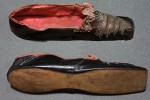 My favorite incoming link of the year wasn’t about bringing in the view numbers, though, which were tiny. It was from a Greek foot fetish forum in which the virtues of Napoleon’s sister’s tiny feet and shoes were extolled. I loved it because it’s the perfect niche audience to appreciate details like the memoirs describing Pauline Bonaparte’s terribly risquée pedicures.
My favorite incoming link of the year wasn’t about bringing in the view numbers, though, which were tiny. It was from a Greek foot fetish forum in which the virtues of Napoleon’s sister’s tiny feet and shoes were extolled. I loved it because it’s the perfect niche audience to appreciate details like the memoirs describing Pauline Bonaparte’s terribly risquée pedicures.
It was a great year overall for the audio-visual arts. Notre Dame got some much-needed new bells for her 850th birthday and on Palm Sunday they made a glorious noise along with the one surviving pre-Revolutionary bell, Emmanuel, installed in 1685. Mary Pickford’s first star-billing film was restored and shown after being found in barn. Orson Welles’ long-lost second film, Too Much Johnson (yes I do snicker at that every time), debuted in theaters in Italy and the US after years of painstaking restoration. Meanwhile, in France, the world’s oldest surviving movie theater reopened after an extensive renovation.
I found the rare sound recordings of Florence Nightingale, Alfred, Lord Tennyson and Martin Leonard Lanfried, trumpeter of the 17th Lancers, hauntingly beautiful. I loved hearing Florence Nightingale express hope in the recording itself that her voice might keep her cause alive long after her death. Audio recording technology was so new then, but her instincts were right on the money. We also got to enjoy the distinct privilege of Alexander Graham Bell ordering us to hear his voice. The first and only known recording of Alexander Graham Bell, it allows this great inventor of live voice transmission technology to finally transmit his own voice to us.
 Advanced technology revived the music played by the the toy pig that saved its owner’s life during the sinking of the Titanic, but to be honest the music was less important to me than the pig itself, which is adorable. I simply cannot resist an adorable pig.
Advanced technology revived the music played by the the toy pig that saved its owner’s life during the sinking of the Titanic, but to be honest the music was less important to me than the pig itself, which is adorable. I simply cannot resist an adorable pig.
Nor can I resist a good, solid medical oddity, which is probably for the best because there’s nothing like an ancient calcified teratoma from the pelvis of Roman woman to counterbalance the cute piggies. The teeth alone are just so freaky. How could a brain boiled in its skull 4,000 years ago compete? You’d probably need a whole online database of diseased medieval bones to even begin to have a chance against it.
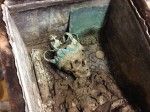 The 3D printed skull of Anna Maria Luisa de’ Medici wearing her Electress Palatine crown isn’t gruesome at all, at least to my eyes, but it is a fascinating glimpse of where the technology could take archaeology going forward. So many things that should not be touched due to condition issues will be able to be examined again thanks to the combination of laser scanning and 3D printing. It’s Anna Maria’s herculean efforts in saving the patrimony of her famous family, the greatest patrons of the some of the greatest art ever made, that should grant her an august place in history. She’s nowhere near as well known as she should be, since she single-handedly ensured that the art that makes Florence a top tourist destination today remain in the city rather than get plundered and scattered around the courts of Europe after her death in 1743.
The 3D printed skull of Anna Maria Luisa de’ Medici wearing her Electress Palatine crown isn’t gruesome at all, at least to my eyes, but it is a fascinating glimpse of where the technology could take archaeology going forward. So many things that should not be touched due to condition issues will be able to be examined again thanks to the combination of laser scanning and 3D printing. It’s Anna Maria’s herculean efforts in saving the patrimony of her famous family, the greatest patrons of the some of the greatest art ever made, that should grant her an august place in history. She’s nowhere near as well known as she should be, since she single-handedly ensured that the art that makes Florence a top tourist destination today remain in the city rather than get plundered and scattered around the courts of Europe after her death in 1743.
Anna Maria’s story was probably my favorite biographical post of the year. Although, if the entry about Michelangelo’s time in hiding under the New Sacristy of San Lorenzo and the astonishing charcoal sketches he drew on the walls to keep himself sane counts as biography, that one’s a favorite of mine too. Teddy Roosevelt’s early years were great fun to delve into as well, because even though he felt he looked like a “dissolute democrat of the fourth ward,” he sure didn’t act like one.
 Which reminds me, I must take a moment to give all proper praise to the best political button in history. May all your wet dreams be of Al Smith. Oh, and quick update: the button ended up selling for $8,962.50 including the buyer’s premium. It’s a steal, if you ask me.
Which reminds me, I must take a moment to give all proper praise to the best political button in history. May all your wet dreams be of Al Smith. Oh, and quick update: the button ended up selling for $8,962.50 including the buyer’s premium. It’s a steal, if you ask me.
The original Batmobile from the 1960s television series was a steal at any price, even $4.62 million, because of its unparalleled awesomeness. Even before it was the greatest of all Batmobiles it was already epic as a Lincoln Futura concept car. I loved researching that because it reminded me of Homer Simpson’s dream car that bankrupted his long-lost half-brother Herb. (Most things remind me of The Simpsons in some way.)
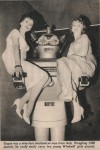 That Batmobile went to a private collector as did the Maltese Falcon (sold for $4,085,000 including buyer’s premium). The debonair 1950s robot Cygan sold to a private collector, but he has contacted me and he is restoring it most judiciously so huzzah! I love the Cygan entry even more now, incidentally, because I had to research the Windmill Girls to write it which means I was able to get the reference to them on the Christmas special of Call the Midwife that just aired on my local PBS station. (Nurse Lee reassured an overdue patient that the midwives are like the Windmill Girls: open all day. Naughty!)
That Batmobile went to a private collector as did the Maltese Falcon (sold for $4,085,000 including buyer’s premium). The debonair 1950s robot Cygan sold to a private collector, but he has contacted me and he is restoring it most judiciously so huzzah! I love the Cygan entry even more now, incidentally, because I had to research the Windmill Girls to write it which means I was able to get the reference to them on the Christmas special of Call the Midwife that just aired on my local PBS station. (Nurse Lee reassured an overdue patient that the midwives are like the Windmill Girls: open all day. Naughty!)
Museums won big this year too. The exquisite lost golden chest of Cardinal Mazarin, the largest known lacquer artifact in the world once used as a TV stand and bar, sold for $9,544,000 including buyer’s premium to the Rijksmuseum. The Royal Museums Greenwich were able acquire the Gibson family shipwreck pictures which will make this invaluable resource available to the public.
![]() My favorite discoveries of the year are both vast and modest in scope. There are the ever so many would-be Pompeiis: the pre-construction excavation revealing 400 years of Roman London, the remains of a 5th century fort massacre on Öland, the man in armor trapped by the eruption of Mount Haruna in the early 6th century A.D. and the slice of Thessaloniki’s history from the Roman era through the 9th century. Thankfully nobody called the
My favorite discoveries of the year are both vast and modest in scope. There are the ever so many would-be Pompeiis: the pre-construction excavation revealing 400 years of Roman London, the remains of a 5th century fort massacre on Öland, the man in armor trapped by the eruption of Mount Haruna in the early 6th century A.D. and the slice of Thessaloniki’s history from the Roman era through the 9th century. Thankfully nobody called the
monumental 6th c. Maya frieze found in Guatemala a Pompeii; its enormous size, fine preservation and sheer beauty give it all the cachet it needs.
 Then there are the exceptional little local treasures like the medieval coins found buried in a shoe in Rotterdam, the first Earl of Sandwich’s recipe for iced chocolate, the outline of a foot carved by a bored Viking on the deck of his ship 1100 years ago, the papyrus spreadsheet in hieroglyphics complete with headers in red and black gridlines, or the medieval leather peytrel found in Cork castle.
Then there are the exceptional little local treasures like the medieval coins found buried in a shoe in Rotterdam, the first Earl of Sandwich’s recipe for iced chocolate, the outline of a foot carved by a bored Viking on the deck of his ship 1100 years ago, the papyrus spreadsheet in hieroglyphics complete with headers in red and black gridlines, or the medieval leather peytrel found in Cork castle.
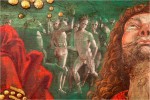 Tiny in size but not in import is the ostrich egg globe that may be oldest globe to include the New World. I’m also partial to the 18th c. wooden railway found in Newcastle shipyard which was standard gauge a century before there was a standard, and to what may be the
Tiny in size but not in import is the ostrich egg globe that may be oldest globe to include the New World. I’m also partial to the 18th c. wooden railway found in Newcastle shipyard which was standard gauge a century before there was a standard, and to what may be the
first images of Native Americans drawn in Europe, found during restoration of a Pinturicchio fresco in the Vatican’s Borgia Apartment.
 It was a good year for shiny things as well. The intensely beautiful Cheapside went on display for first time in all its glory. A modest farm in Denmark yielded a collection of
It was a good year for shiny things as well. The intensely beautiful Cheapside went on display for first time in all its glory. A modest farm in Denmark yielded a collection of
elite Viking jewelry that was in part reminiscent of the oeuvre of H. R. Giger. Augustus Saint-Gaudens’ golden statue of Diana the Huntress that once perched on one foot over the second Madison Square Garden, a fine vantage point for witnessing the scandalous murder of architect Stanford White, is being regilded after years in the elements stripped her of her original glitter. A 12th c. bishop’s ring that was stolen from St. Peter’s Cathedral in Bremen was found when the culprit voluntarily confessed because his conscience bothered him.
If only the Norton Simon Art Foundation in Pasadena had the baseline honesty of a German drug-addicted thief, then Cambodia would have four of its invaluable statues looted from the Prasat Chen temple in Koh Ker during the chaos of the early 1970s. As it is, they have the two Kneeling Attendants, returned by the Metropolitan Museum of Art and Duryodhana, returned by Sotheby’s after years of legal wrangling.
 Also returned this year were the lost artifacts of two World War II veterans. The ring pilot David C. Cox had to trade to survive his imprisonment Stalag VII-A was returned to his grateful son by Martin Kiss of Hohenberg, Bavaria, who asked for no remuneration at all, not even shipping costs. The greatest tear-jerker of the year was the story of Peggy Eddington-Smith, who finally received the letter the father she never met wrote to her before his death in Italy. I defy anyone of human parts to read that story without crying.
Also returned this year were the lost artifacts of two World War II veterans. The ring pilot David C. Cox had to trade to survive his imprisonment Stalag VII-A was returned to his grateful son by Martin Kiss of Hohenberg, Bavaria, who asked for no remuneration at all, not even shipping costs. The greatest tear-jerker of the year was the story of Peggy Eddington-Smith, who finally received the letter the father she never met wrote to her before his death in Italy. I defy anyone of human parts to read that story without crying.
And now off with ye all. Celebrate tonight with much revelry and come back tomorrow to read through squinted eyes and pounding head. Thank you for choosing The History Blog for your history blog reading needs in 2013. I hope to continue to make it worth your while in 2014. Happy New Year! :boogie:
